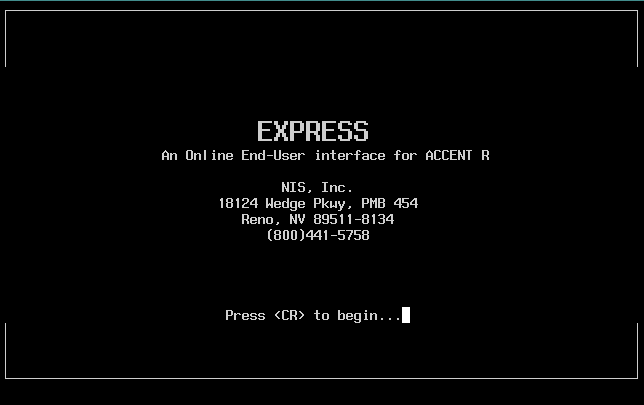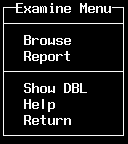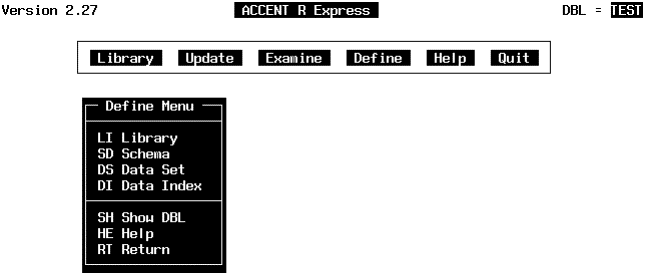
PURPOSE: This chapter introduces ACCENT R concepts and terminology, explains how to start ACCENT R and an Express session, and outlines the Express menus. Those already experienced with ACCENT R may skip the first section or use it as a review.
To gain the full benefit of Express, you need to know a few basic concepts of ACCENT R and its terminology.
Data is actually stored in a file called a Data Set (DS. A Data Set is a table of rows (called records) and columns (called fields). Each data item is stored in a field (Example: name, address, and phone). A record consists of a single value for a complete set of fields. A data set is made up of a complete set of records.
To create a Data Set, you need to tell Express what fields are to be used, the data type (dates, numbers, letters), and the maximum number of characters that can be entered. The Data Set description is called a Schema Definition (SD).
Data is usually sorted in a specific way for reports. Trying to keep the data in a specified order as it is entered is difficult if not impossible. Sorting data after every data entry is time consuming. To make data processing efficient, Express uses a Data Index (DI). A Data Index tells Express how the data should be sorted during retrieval. A Data Index allows for multiple sorts and multiple levels within sorts for a single Data Set.
All the information relative to your data is stored in a Database Library (DBL). The Database Library contains the objects described above Data Set, Schema Definition, and Data Index. Data Sets and Data Indexes are stored in separate system files from the Database Library. ACCENT R creates and accesses this information for you as needed.
A Database Library may contain multiple Schema Definitions with each associated to multiple Data Sets. The Database Library may also contain other objects not described here. Refer to the ACCENT R Reference Manual for information on other DBL objects and their uses.
A Process Module (PM) is a file containing statements that provide detailed specifications for processing records of Data Sets. Express generates PMs for various functions which can be saved, then modified outside of Express.
In this manual, the database library and its objects are referred to by their abbreviation. Other terms and symbols are used which may be unfamiliar. Refer to the following guide when needed as you go through the text. Keys are indicated by brackets (<>):
<RETURN> or <CR>, <LINE FEED> or <LF>, <BACK SPACE> or <BS>.
[Refresh Screen] <CTRL> R: (hold) Control Key (and type) R
[Display Options] <CTRL>W: (hold) Control Key (and type) W
[Exit Function] <CTRL> Z: (hold) Control Key (and type) Z
DBL - Database Library
DI - Data Index
DS - Data Set
PM - Process Module
SD - Schema Definition
SQL - Structured Query Language
First, start the ACCENT R session by entering ACCENT at the system prompt. The default prompt for the ACCENT R command line is an asterisk (*). Next, enter EXPRESS at the ACCENT R command line to invoke Express. A banner window will appear (Figure 1). Press <RETURN> to display the Express Master menu (Figure 2).


Once inside Express, most of the instructions that you will need are displayed on the screen. If there is something that you do not understand, press the question mark key (?) for more information on the item highlighted by the cursor.
NOTE: Most functions require a Data Set (DS) to be declared. Express will prompt for a DS name with the last declared DS as the default.
All Express functions are accessed through the Master menu. To 'select' a menu item, move the cursor to the desired menu item by pressing the left or right arrow keys. You can also type the first letter of the menu item to move the cursor into position. Once the menu item is highlighted, press <RETURN> to invoke the selected menu or function.
The secondary menus are displayed vertically. Use the up or down arrows to place the cursor on the desired option. You can also type the first unique letters of the option to move the cursor into position. Once the option is highlighted, press <RETURN> to invoke the function.
NOTE: If you move the cursor twice or more consecutively by typing the first unique letters of a menu item (without pressing <RETURN> or an arrow key between such moves), you must enter the menu item letters twice for the second (and each succeeding) cursor move. The terminal will just beep the first time the letters are entered for the second and succeeding consecutive moves.
Declare a new or existing Database Library (DBL) with the Library menu. The LIBRARY option is highlighted in the Master menu when a session is started or after exiting any menu or function (except QUIT). You can also specify external databases to be used. Press <RETURN> to invoke the Library menu.

|
USE DBL |
Specify the DBL to use. If a non-existent DBL name is entered, Express verifies if you want to create a new one (default is NO). The selected DBL name will appear in the top right comer of the screen. This menu item is highlighted when the Library menu is entered and after returning from one of the other Library menu functions. |
|
USE NO DBL |
Clears the current DBL. The DBL name in the top right comer becomes blank. |
|
SHAREBASE |
Select Sharebase processing which is available only in the Sharebase version of ACCENT R. |
|
SYBASE |
Select Sybase processing which is available only in the Sybase version of ACCENT R. You can logon or logoff the Sybase server. |
|
RDB SOL |
Select Rdb processing which is available only in the Rdb version of ACCENT R. Specify the Rdb schema name to be used. |
|
ORACLE |
Select Oracle processing which is available only in the Oracle version of ACCENT R. You can logon or logoff the Oracle server. |
|
COMMANDS |
Display a list of ACCENT R commands that are available for use with the declared DBL. Refer to Chapter 7 for more details. |
Certain versions of ACCENT R are able to work with a specified external database (Rdb, Sybase, Oracle, and Sharebase). The software version also dictates which or if an external database can be used by Express. In the proper version, you can logon or logoff the Oracle or Sybase server without having to exit Express. The Rdb schema can be declared or changed without leaving Express. Full validations of passwords, database names, and schema names are performed.
In Oracle table processing, all tables (or DSs) must have the same form type as the main table/DS. Express will display an error message if the form types are mixed. Refer to the SQLgateway manuals for more information on a specific database.
The Library, Update, Examine, and Define menus have a common auxiliary menu with the SHOW, HELP, and RETURN functions. Refer to Chapter 8 for more information on SHOW.
|
SHOW DBL |
Display contents of the current DBL or its objects (DS, SD, and DI). |
|
HELP |
Display information about the current menu. |
|
RETURN |
Go back to the Master menu. |
Add, change, or delete data in a Data Set (DS) with the Update menu functions. Refer to Chapter 4 for more information on the functions in this menu. A DBL must be declared before the Update menu can be displayed.

|
ADD |
Enter data for new DS or add records to an existing DS. This menu item is highlighted when the Update menu is entered and after returning from one of the other, Update functions. |
|
CHANGE |
Change data for selected fields. |
|
ALTER |
Make a global change in a DS based on a specified condition. All records will be affected by the change. |
|
DELETE |
Remove records from a DS. |
The Examine menu allows you to analyze data on the screen. You can also form reports from all or selected fields from an existing Data Set (DS). Refer to Chapter 5 for more information on the functions in this menu. A DBL must be declared before the Examine menu can be displayed.

|
BROWSE |
Review data on screen. This menu item is highlighted when the Examine menu is entered or after returning from the other Examine function. |
|
REPORT |
Create a report to show all or selected fields. You can sort data, calculate totals, and specify criteria for record inclusion. |
The Define menu is used to create a database library (DBL) and itís various objects. Refer to Chapter 3 for more information on this creation process. A DBL must be declared before the define menu can be displayed.

|
LIBRARY |
Declare or create a DBL (same function as Use DBL in the Library menu). This menu item is highlighted when the Define menu is entered and after returning from one of the other, Define functions. |
|
SCHEMA |
Create or modify the Schema Definition (SD). Refer to Chapter 6 for details on modifying an SD. |
|
DATA SET |
Create a Data Set (DS) and identify the SD that describes the form and content of the data that is stored in the DS. |
|
DATA INDEX |
Create a Data Index (DI) and identify the associated DS so that the data can be accessed in a certain logical order. |
Display information about the Master menu through the HELP option. Use the arrow keys or type H to highlight the HELP option, then press <RETURN>

Terminate the Express session through the QUIT function. Use the arrow keys or type Q to highlight the QUIT option, then press <RETURN>. This function returns control to the ACCENT R command line (or to GUIDE if Express was invoked from that utility).
The 'default' menu option is already highlighted when a given menu is displayed. The cursor does not need to be moved before pressing <RETURN> to invoke the default option.
Pressing <RETURN> without an entry to an Express prompt will return control to the previous menu.
Fields can be selected from a list by typing the first unique letters or highlighting with the cursor and pressing <RETURN>. Use the arrow keys to place the cursor.
Every field selected for a criterion must be given a condition. Otherwise, Express will re-prompt for an entry.
Express displays error messages at the bottom of the screen for a variety of reasons. Press <RETURN> to exit error message and continue working.